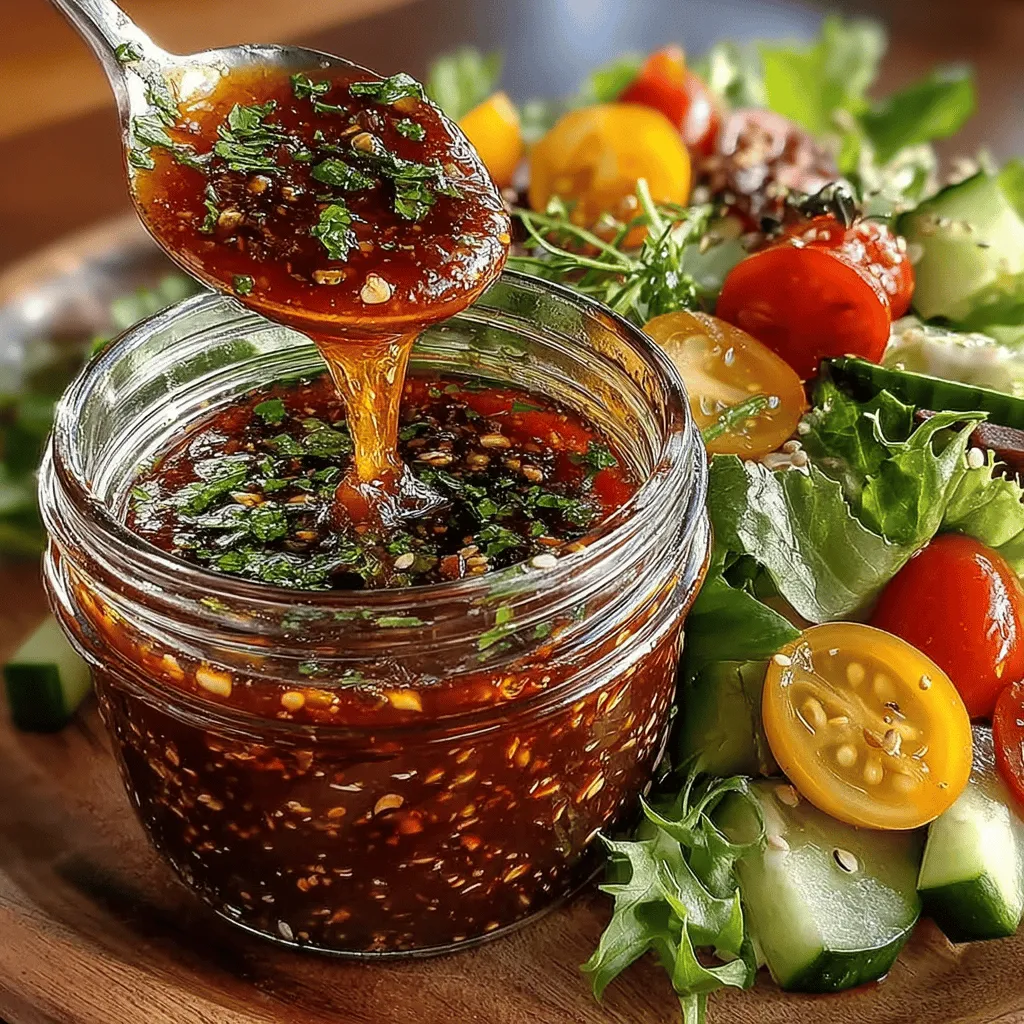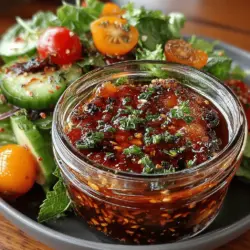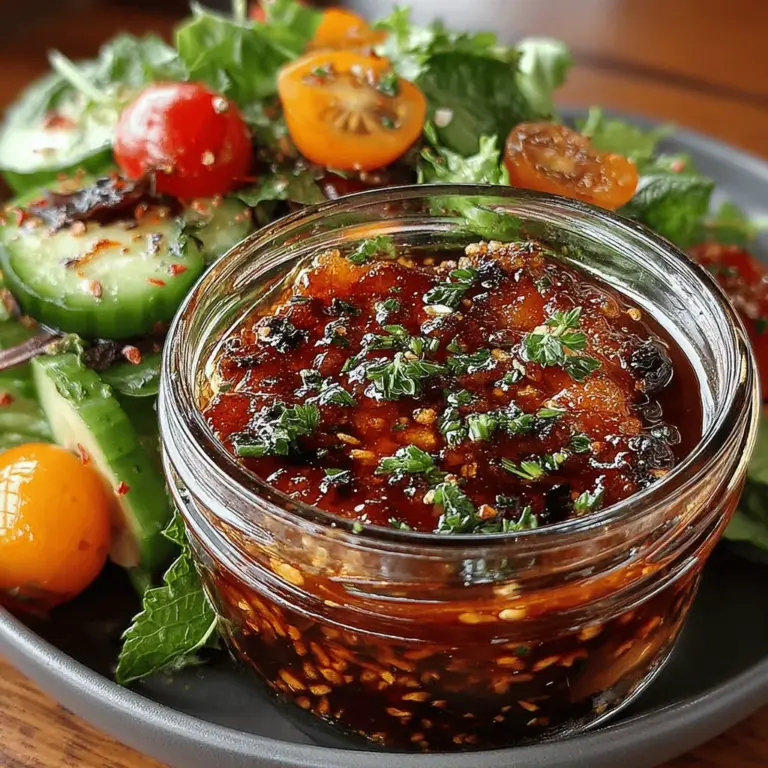Introduction to Weekend Balsamic Vinaigrette
Homemade dressings are a game-changer in the world of culinary flavor. Unlike store-bought options, which often contain preservatives, excess sugar, and artificial ingredients, making your own dressing allows you to control what goes into it. This not only ensures a fresher taste but also allows you to customize flavors to suit your personal preferences. Among the myriad of homemade dressings, the Weekend Balsamic Vinaigrette stands out for its simplicity and versatility. Whether you are preparing a light salad, grilling vegetables, or marinating meats, this vinaigrette can elevate your dishes with its rich flavor profile and balanced ingredients.
The beauty of the Weekend Balsamic Vinaigrette lies in its ease of preparation, making it an ideal choice for weekend meal prep. With just a handful of ingredients and minimal time investment, you can whip up a delicious dressing that complements your favorite dishes. The vinaigrette’s robust flavors can enhance everything from leafy greens to roasted vegetables, making it a staple in any kitchen.
Understanding the Ingredients
Creating the perfect balsamic vinaigrette requires a careful selection of ingredients, each playing a vital role in building flavor and texture. Here’s a closer look at what goes into this delightful dressing:
Extra-Virgin Olive Oil
The backbone of any vinaigrette is the oil, and in this case, high-quality extra-virgin olive oil is essential. Renowned for its rich flavor and numerous health benefits, extra-virgin olive oil is packed with monounsaturated fats, which are heart-healthy and can help reduce inflammation. The oil also provides a smooth mouthfeel and serves as the base that carries other flavors in the vinaigrette. Opting for a good quality olive oil can make a significant difference in the overall taste of your dressing.
Balsamic Vinegar
Balsamic vinegar is the star ingredient in this vinaigrette, known for its distinct sweet and tangy flavor. Originating from Modena, Italy, authentic balsamic vinegar is made from freshly pressed grape must and aged for several years, resulting in a complex taste profile that can be both rich and fruity. This unique vinegar not only provides a sharp acidity that balances the oil but also contributes a depth of flavor that enhances salads, marinades, and even dipping sauces.
Dijon Mustard
Adding Dijon mustard to your vinaigrette serves two primary purposes: it acts as an emulsifier and adds a layer of complexity to the flavor. The mustard helps bind the oil and vinegar together, preventing them from separating, which is crucial for achieving a smooth and cohesive dressing. Additionally, the subtle spiciness of Dijon mustard complements the sweetness of balsamic vinegar, creating a well-rounded flavor that tantalizes the palate.
Honey or Maple Syrup
To achieve the perfect balance in your balsamic vinaigrette, incorporating a touch of sweetness is key. Honey or maple syrup can effectively balance the tanginess of the balsamic vinegar, enhancing the dressing’s overall flavor. Honey provides a floral sweetness, while maple syrup offers a unique earthy note. Depending on your preference or dietary needs, either option works beautifully to round out the vinaigrette’s taste.
Garlic
Garlic adds aromatic depth to the vinaigrette, infusing it with a warm, savory note. Beyond its flavor, garlic is known for its numerous health benefits, including its potential to boost the immune system and lower blood pressure. Whether you prefer fresh minced garlic for a more intense flavor or roasted garlic for a milder, sweeter taste, this ingredient can significantly enhance your balsamic vinaigrette.
Seasonings: Sea Salt and Black Pepper
No vinaigrette is complete without the right seasonings. Sea salt and freshly cracked black pepper elevate the overall flavor, bringing out the best in each ingredient. Salt helps to enhance the natural flavors, while black pepper adds a subtle kick. The right balance of seasoning can transform a simple dressing into a culinary masterpiece, so don’t underestimate their importance.
Optional Additions: Dried Italian Herbs and Red Pepper Flakes
For those looking to add an extra layer of complexity, consider incorporating optional ingredients like dried Italian herbs or red pepper flakes. Dried herbs such as oregano, basil, or thyme can lend an aromatic quality to the vinaigrette, making it even more versatile for various dishes. Meanwhile, a pinch of red pepper flakes can introduce a hint of heat, perfect for those who enjoy a bit of spice in their dressings.
Step-by-Step Preparation of Balsamic Vinaigrette
Now that we’ve explored the essential ingredients that contribute to the Weekend Balsamic Vinaigrette, let’s move on to the preparation process. Following these straightforward steps will ensure you create a delicious and well-balanced dressing every time.
Mixing the Base Ingredients
Begin by gathering all your ingredients together. In a medium-sized bowl or a mason jar, combine the balsamic vinegar, Dijon mustard, honey (or maple syrup), and minced garlic. This initial mixing is crucial for flavor integration, as it allows the tangy vinegar, sweetener, and aromatic garlic to meld together. Use a whisk or a fork to stir until the mixture is well combined.
Emulsifying the Dressing
The next step is to emulsify the dressing by slowly whisking in the extra-virgin olive oil. This process is vital for achieving a smooth, cohesive texture. Start by adding the olive oil gradually while continuously whisking; this helps to create a stable emulsion that prevents the oil and vinegar from separating. If you prefer a simpler method, you can combine all the ingredients in a mason jar, secure the lid, and shake vigorously until emulsified.
Adjusting Flavor Profiles
After emulsification, it’s time to taste your dressing. This is where you can make adjustments to suit your personal preferences. If you find it too tangy, consider adding a little more honey or maple syrup. If it lacks depth, a bit more Dijon mustard or garlic can enhance the flavor. Don’t hesitate to experiment with the seasoning as well; a pinch of salt or a dash of black pepper can make a world of difference.
Chilling Time and Flavor Development
Once you’re satisfied with the flavor, allow the balsamic vinaigrette to chill in the refrigerator for at least 30 minutes. This chilling time is not just about cooling the dressing; it allows the flavors to meld and develop, resulting in a more robust and harmonious taste. When you’re ready to serve, give the vinaigrette a good shake or stir, as separation may occur during chilling.
In the next section, we will explore how to use this versatile vinaigrette in various dishes, ensuring you get the most out of your Weekend Balsamic Vinaigrette creation. Stay tuned!

Serving Suggestions for Weekend Balsamic Vinaigrette
Balsamic vinaigrette is not just a dressing for salads; it’s a versatile culinary gem that can elevate a variety of dishes. Here are some creative ways to incorporate this simple yet flavorful vinaigrette into your meals.
Salads
When it comes to salads, the possibilities are endless. This balsamic vinaigrette pairs beautifully with various ingredients, enhancing the taste and presentation of your dishes. Here are a few salad combinations to inspire your culinary creativity:
– Mixed Greens Salad: Combine baby spinach, arugula, and romaine lettuce. Toss in sliced strawberries, walnuts, and crumbled feta cheese, then drizzle with your balsamic vinaigrette for a refreshing and vibrant salad.
– Roasted Vegetable Salad: Roast seasonal vegetables such as bell peppers, zucchini, and carrots. Once cooled, mix them with mixed greens and a handful of quinoa. The balsamic vinaigrette will complement the sweetness of the roasted veggies perfectly.
– Grain-Based Salad: Use farro or barley as a base for a hearty salad. Add chopped cucumbers, cherry tomatoes, and parsley, and finish with a generous splash of balsamic vinaigrette. This combination is not only filling but also packed with nutrients.
Grilled Vegetables
Transform your grilled vegetable dishes with the addition of balsamic vinaigrette. Before grilling, marinate vegetables like bell peppers, eggplants, and asparagus in the vinaigrette for about 30 minutes. This process infuses them with flavor and enhances their natural sweetness. After grilling, drizzle a bit more vinaigrette over the top for an added zing. This method not only makes the vegetables taste incredible but also creates a beautiful char that adds depth to your dishes.
Marinades for Meats
Balsamic vinaigrette is an excellent marinade for various proteins, including chicken, fish, and tofu. The acidity of the vinegar helps tenderize the meat, while the flavors deepen as it marinates.
– Chicken: For a simple yet delicious chicken dish, marinate boneless chicken breasts in balsamic vinaigrette for at least an hour before grilling or baking. The result is juicy, flavorful chicken that pairs well with a side of roasted vegetables.
– Fish: Use the vinaigrette to marinate salmon or tilapia. Allow the fish to soak for about 30 minutes, then grill or bake. The balsamic glaze will caramelize slightly, creating a flavorful crust that enhances the fish’s natural taste.
– Tofu: For a plant-based option, cube firm tofu and marinate it in balsamic vinaigrette for a couple of hours before sautéing or grilling. This method adds depth and flavor to the tofu, making it an excellent addition to grain bowls or salads.
Dipping Sauce
Balsamic vinaigrette can also serve as a delightful dipping sauce. Pair it with fresh bread for a simple appetizer that everyone will love. Alternatively, serve it alongside a platter of fresh vegetables like carrots, cucumbers, and bell pepper strips. This not only adds a burst of flavor but also encourages healthy snacking.
Storing and Shelf Life of Balsamic Vinaigrette
To keep your balsamic vinaigrette fresh and flavorful, proper storage is crucial. Here are some tips for storing your homemade dressing:
Container Recommendations
Using the right container can significantly impact the shelf life of your vinaigrette. Opt for glass jars with airtight seals, as they help preserve the freshness and prevent any unwanted odors from affecting the flavor. Mason jars are a great choice since they are easy to clean and have a secure lid.
Refrigeration
Refrigeration is key to maintaining the quality of your balsamic vinaigrette. The cold temperature slows down any microbial growth, keeping the dressing safe for longer. Before using, simply take the jar out of the fridge and give it a good shake or stir to recombine the ingredients, as they may separate over time.
Shelf Life
Homemade balsamic vinaigrette can be stored in the refrigerator for up to two weeks. Keep an eye out for signs of spoilage, such as off odors, changes in color, or unusual separation. If any of these occur, it’s best to discard the vinaigrette and make a fresh batch.
Nutritional Benefits of Balsamic Vinaigrette
Homemade balsamic vinaigrette is not only delicious but also boasts several health benefits due to its wholesome ingredients. Understanding these benefits can motivate you to incorporate this dressing into your meals regularly.
Heart-Healthy Fats from Olive Oil
The primary ingredient in balsamic vinaigrette is olive oil, which is known for its heart-healthy fats. Rich in monounsaturated fats, olive oil can help lower bad cholesterol levels and decrease the risk of heart disease. Incorporating healthy fats into your diet is essential for overall well-being, making this vinaigrette a smart choice.
Vitamins and Antioxidants
Balsamic vinegar, another key ingredient in the vinaigrette, is packed with vitamins and antioxidants. It contains acetic acid, which has been shown to lower blood sugar levels and improve insulin sensitivity. Additionally, garlic, often included in the recipe, is known for its immune-boosting properties and is rich in antioxidants that help combat oxidative stress in the body.
Natural Sweeteners
If you choose to include natural sweeteners such as honey or maple syrup in your vinaigrette, you’re making a healthier choice compared to refined sugars. Honey and maple syrup provide a touch of sweetness while also offering vitamins and minerals that refined sugars lack. This makes your vinaigrette not only tasty but also nutritious.
Conclusion: Embracing Homemade Dressings
Making your own balsamic vinaigrette is not just about flavor; it’s about embracing a healthier lifestyle. By preparing this dressing at home, you can control the ingredients, experiment with flavors, and create a condiment that perfectly suits your taste preferences.
With its versatility, you can use balsamic vinaigrette in salads, marinades, and as dipping sauces, making it an essential staple in your kitchen. The health benefits of the ingredients further enhance its appeal, proving that delicious eating can also be nutritious.
Encourage yourself to experiment with this recipe, adapting it to your own culinary style. Whether you prefer a tangier vinaigrette or one with a hint of sweetness, the possibilities are endless. So, go ahead and elevate your meals with homemade balsamic vinaigrette, and enjoy the vibrant flavors and health benefits it brings to your table.

